There is a 20 picture limit per post, so I am continuing the story in a new post.
1939 saw several changes to V8 engines. The biggest changes were due to the introduction of the Mercury. The Mercury had an engine based on the Ford V8, but with a noticeable increase in torque and a nice bump in horsepower. The additional power came as the result of additional displacement, 239 cubic inches instead of Ford's 221 cubic inches. The additional cubic inches came from a 1/8 inch larger bore, to 3 3/16 inches. Now we have the reason for 24 studs per head. The lower line of studs on the 21 stud motors is too close to the bore for safe production of 239 cubic inch motors. With the addition of more power came larger main and rod bearings, this time 2.500 inch diameter mains and 2.140 inch diameter rods. The Ford blocks got the bigger mains too, but continued with the smaller 2.000 inch rod bearings. Another difference started with 1939 motors is a longer crankshaft. Ford and Mercury mounted the engine fan on the end of the crankshaft in 1939, 1940, and 1941. To allow the fan to be held onto the snout of the crankshaft, the snout was made longer. Starting in 1939 some V8 blocks were relieved between the valves and the bore at the factory. This was done to reduce compression and detonation problems on large trucks. Both 3 1/16 bore and 3 3/16 bore blocks may be factory relieved. All blocks still have four freeze plugs in the oil pan rails.
The deck and front of the block on the 221 cubic inch Ford motor is almost identical to the 1937-1938 21 stud motor, with the exception of 24 head studs. The water holes in the deck and other similarities can be seen the following two pictures. These blocks can be bored 1/8 over to 239 cubic inch size so a 3.1875 bore should not be used to determine block identity.

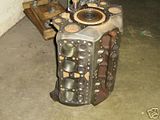
The 239 cubic inch Mercury engine was also optional in trucks. The water holes in the deck feature a circular center instead of the upside down keystone. Some 239 blocks had 99 stamped into the passenger side intake rail near the front, but not all. As with the LB, an unscrupulous person could have added this marking to a less desirable engine also. The determination on one of these blocks should be made using the center water holes in the deck. Mercury motors will have an upside down keystone at the bottom and a circular hole in the middle. These can be seen in the following picture. This is a factory relieved new old stock block owned by a Ford Barn member.
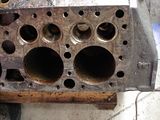
1940 engine blocks are identical to 1939 blocks as far as 221 and 239 motors are concerned. Interesting things were happening to the 60 horsepower motors, but that is a different story.
1941 feature some detail changes compared to all the previous 221 and 239 cubic inch V8 motors. The freeze plugs in the oil pan were eliminated and the intake deck is no longer flat. This is referred to as a raised intake block, but actually the intake is the same height and the surrounding area is sunken a bit. This was probably done to save a bit of cast iron and prolong cutting tool life. Another interesting feature of the 1941 motors is the outside wall of the block that the exhaust ports exit through. 1932 through 1940 blocks are flat with raised exhaust ports. 1941 blocks are curved between the exhaust ports. The 221 and 239 cubic inch blocks can still be differentiated by the center water holes in the cylinder head decks.
The curve in the outer block wall and the raised intake can be seen in this picture. Compare the block side in this picture to the block sides in the lower 1939 Ford block picture.
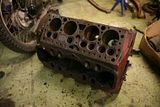
The flat oil pan rail without the bulges for freeze plugs can be seen in this picture.

1942 blocks were the same, Ford and Mercury, to 1941 blocks.
All prewar, 1932 through 1942, V8 blocks will pass what is known as the pencil test. The front of the block above the timing cover has a little shelf that makes the top of the timing cover face in the block. If you can rest a pencil on the block at this location, you have a prewar block. Make sure you are not resting the pencil on the timing cover itself. Here is a picture of a 1938 motor passing the pencil test.
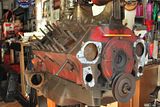
Also, be wary of Ford literature on engine identification. Ford did not care about correct year blocks, Ford cared about whether the engine would bolt into and be usable in a particular car. A good example of this can be found on this identification page. The 1932, and 1933-1934 blocks are all wrong in this example. The features specific to performing maintenance on any particular year car or truck are correct.
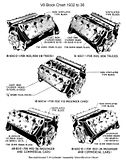
World War 2 – I have no idea what all the flatheads during the war years looked like. I have seen pictures of military engines with features similar to the French flatheads and I have seen a picture of a G series six cylinder with a front mounted post distributor. It is an interesting subject, but not one I can add much to.
1946 Ford and Mercury engines are identical. This is the start of the 59 series motors. All engines feature 3 3/16 bore by 3 ¾ stroke for 239 cubic inches. The blocks have a 59 cast on the top of the bell housing, if someone hasn't ground it off. The front of the block now slopes from the intake rail down to the timing cover so the pencil test fails. The intake rail is back to flat. The water holes in the bottom center and middle center of the cylinder head deck are round. The cast in bell housing still has holes for the engine steady rods. Main bearings are 2.500 inches and rod bearings are 2.140 inches. Sometime during the war, Ford changed the angle between the valves. Pre-war blocks have 101.5 degrees between the valve centerlines and postwar blocks have 100 degrees between valve centerlines. This means the valves are about 0.090 inches further away from the bore on postwar blocks. This was done to reduce cracking between the valve ports and the bore. This also affects the cam timing a bit, so be careful that the cam you use is for the series motor you are using it in.
Here is an example of a 59 cast on the bell housing. This particular block has an L, there are many other letters that can be found here, or no letter at all. There has been a lot of conjecture about certain blocks being either Canadian or Military and having either thicker walls or more nickel in the castings. I am not aware of any metallurgical testing of blocks, so for practical purposes, all 59 series blocks in good condition are equivalent.

The intake rail is clearly flat again as can be seen in this picture. Someone has relieved this block around the valves following a head gasket as a guide.
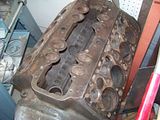
The circular water holes in the center of the cylinder head deck can clearly be seen in this picture.

1947 Ford and Mercury engines are identical to 1946.
1948 Ford and Mercury engines are identical to 1946 with the exception that the new 1948 pickups had the new 8BA style engine.
1949 Ford and Mercury blocks are identical with 3 3/16 inch diameter bore. There is no cast on bell housing. These motors featured revised cooling passages, most notably at the top of the water pumps and at the rear of the cylinder head deck. Engine oil passages are revised slightly to eliminate the pressure relief valve at the front of the valley. The crankcase ventilation system is revised, with the crankcase breather and road draft tube coming off the intake manifold. Main and connecting rods continue with the same diameter as before, but the connecting rod bearings are not floating and are individual per rod. The crankshafts now have two oil holes per crank throw instead of one. Distributors are now post style in front of the passenger side head. The fan belts an pulleys are moved forward to make room for the new distributor (this can cause problems when trying to put an 8BA into a 1932, 1933, or 1934 Ford). Ford engine continue with 239 cubic inches, but Mercury goes to a 4 inch stroke to get 255 cubic inches.
The revised cooling passage at the rear of the cylinder head deck can be seen in this picture.
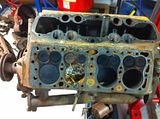
The added cooling passage at the top of the water pump can be seen in this picture.
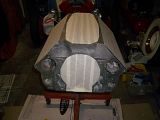
The back of the block with no cast on bell housing can be seen in this pictures. This block has been modified for a full flow oil filter.

1950 Ford and Mercury passenger cars switch from wide belts to narrow belts. The blocks are identical to 1949.
1951 Ford and Mercury started using rotating exhaust valves during this year. Also, the hardened intake valve seats were eliminated and the intake seats were cut directly into the block sometime around 1951 production.
1952 Blocks are the same as 1949 blocks with the exception of not having hardened intake valve seats from the factory. Somewhere in this time frame the hardened exhaust valve seats were phased out too.
1953 Blocks are the same as 1949 blocks with the exception of not having hardened intake valve seats and possibly not having hardened exhaust valve seats from the factory.
1954 Canadian and Canadian sourced cars still have the flathead. Blocks are the same as 1949.